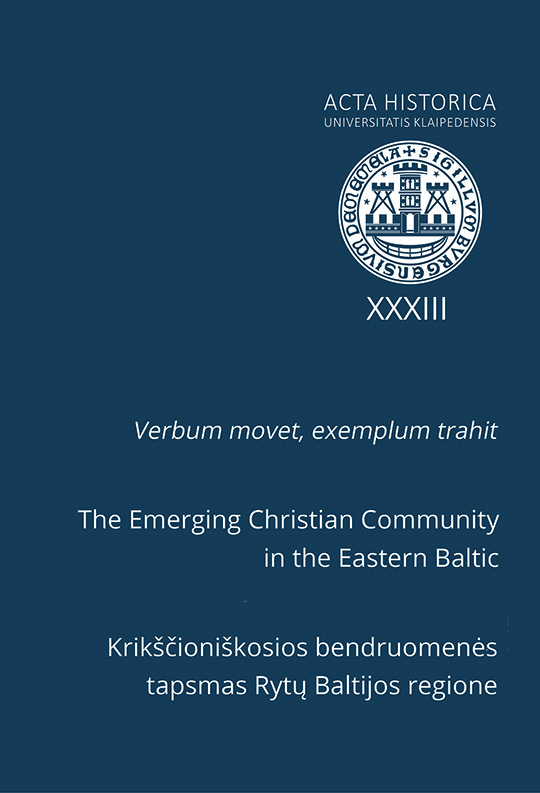Volume 33 (2016): Verbum movet, exemplum trahit. The Emerging Christian Community in the Eastern Baltic = Verbum movet, exemplum trahit. Krikščioniškosios bendruomenės tapsmas Rytų Baltijos regione, December 2016

Order by:
Pub. online: 15 Dec 2016
Type: Editorial Note
 Open Access
Open Access
Journal:
Acta Historica Universitatis Klaipedensis
Volume 33 (2016): Verbum movet, exemplum trahit. The Emerging Christian Community in the Eastern Baltic = Verbum movet, exemplum trahit. Krikščioniškosios bendruomenės tapsmas Rytų Baltijos regione, pp. 5–6
Pub. online: 15 Dec 2016
Type: Introduction
 Open Access
Open Access
Journal:
Acta Historica Universitatis Klaipedensis
Volume 33 (2016): Verbum movet, exemplum trahit. The Emerging Christian Community in the Eastern Baltic = Verbum movet, exemplum trahit. Krikščioniškosios bendruomenės tapsmas Rytų Baltijos regione, pp. 7–13
Pub. online: 15 Dec 2016
Type: Introduction
 Open Access
Open Access
Journal:
Acta Historica Universitatis Klaipedensis
Volume 33 (2016): Verbum movet, exemplum trahit. The Emerging Christian Community in the Eastern Baltic = Verbum movet, exemplum trahit. Krikščioniškosios bendruomenės tapsmas Rytų Baltijos regione, pp. 14–19
Pub. online: 15 Dec 2016
Type: Article
 Open Access
Open Access
Journal:
Acta Historica Universitatis Klaipedensis
Volume 33 (2016): Verbum movet, exemplum trahit. The Emerging Christian Community in the Eastern Baltic = Verbum movet, exemplum trahit. Krikščioniškosios bendruomenės tapsmas Rytų Baltijos regione, pp. 23–46
Abstract
Pub. online: 15 Dec 2016
Type: Article
 Open Access
Open Access
Journal:
Acta Historica Universitatis Klaipedensis
Volume 33 (2016): Verbum movet, exemplum trahit. The Emerging Christian Community in the Eastern Baltic = Verbum movet, exemplum trahit. Krikščioniškosios bendruomenės tapsmas Rytų Baltijos regione, pp. 47–71
Abstract
Pub. online: 15 Dec 2016
Type: Article
 Open Access
Open Access
Journal:
Acta Historica Universitatis Klaipedensis
Volume 33 (2016): Verbum movet, exemplum trahit. The Emerging Christian Community in the Eastern Baltic = Verbum movet, exemplum trahit. Krikščioniškosios bendruomenės tapsmas Rytų Baltijos regione, pp. 75–98
Abstract
Pub. online: 15 Dec 2016
Type: Article
 Open Access
Open Access
Journal:
Acta Historica Universitatis Klaipedensis
Volume 33 (2016): Verbum movet, exemplum trahit. The Emerging Christian Community in the Eastern Baltic = Verbum movet, exemplum trahit. Krikščioniškosios bendruomenės tapsmas Rytų Baltijos regione, pp. 99–119
Abstract
Pub. online: 15 Dec 2016
Type: Article
 Open Access
Open Access
Journal:
Acta Historica Universitatis Klaipedensis
Volume 33 (2016): Verbum movet, exemplum trahit. The Emerging Christian Community in the Eastern Baltic = Verbum movet, exemplum trahit. Krikščioniškosios bendruomenės tapsmas Rytų Baltijos regione, pp. 123–146
Abstract
Pub. online: 15 Dec 2016
Type: Article
 Open Access
Open Access
Journal:
Acta Historica Universitatis Klaipedensis
Volume 33 (2016): Verbum movet, exemplum trahit. The Emerging Christian Community in the Eastern Baltic = Verbum movet, exemplum trahit. Krikščioniškosios bendruomenės tapsmas Rytų Baltijos regione, pp. 147–186
Abstract
Pub. online: 15 Dec 2016
Type: Article
 Open Access
Open Access
Journal:
Acta Historica Universitatis Klaipedensis
Volume 33 (2016): Verbum movet, exemplum trahit. The Emerging Christian Community in the Eastern Baltic = Verbum movet, exemplum trahit. Krikščioniškosios bendruomenės tapsmas Rytų Baltijos regione, pp. 187–203
Abstract